THE ORIGINAL DESIGN
During the period in the late 1940s when the Cold War was at its highest tension with East Berlin under communist rule and the possible threat from China was growing larger NATO was formed. One of the consequences of the Korean War in 1954 was a treaty known as the Paris Accord, which ended the four-part occupation of Germany, which had been in place since the end of the Second World War.
Germany was offered membership of the NATO Alliance and asked to form a frontier close to the Soviet borders of influence and as a result was authorised to design and construct a range of coastal defense submarines of traditional propulsion, and of no more than 350 tons displacement. Immediately the German engineers, with the previous experience of the U-boat design process, began to draw up designs for new boats fitting inside these parameters.
THE 202 CLASS
One prototype was actually designed to the 201 class but very little information seems to be publicly available except that it has a single propeller shaft and drive. Alongside this design lng. Grim, who had participated in the design of the Type XXI II used at the end of the Second World War, also studied a new type of coastal submarine of only 58 tons and of 14.5 metre length. He duly submitted his designs for consideration by the shipyard in Lubeck. They liked the design concept but asked him to enlarge the boat to 1 00 tons surface displacement with a length of 23.1 metres and a beam of 3.4 metres.
The changes meant that this larger boat could accept the modern systems, which in turn would allow it to operate in the role of a coastal ‘Hunter-Killer’ of other similar craft. Even with the hull extended by 8.5 metres. lng. Grim had to adopt a number of clever design ideas to fit in all the machinery and crew required. The torpedo tubes, the operational space, with batteries underneath, the passive and active sonar detection systems al l occupied the forward section of the hull.
Under a large tower which was a quarter of the total volume were located the periscopes, radar, aerials and the Schnorkel, all-retractable. The only space left, at the stern, had the power plant plus space for the six crew members.
A PROJECT WITHOUT A FUTURE?
Although 40 boats were originally considered for the 202 class only three boats were ordered in 1959 under an evaluation programme. Even as the boats were being designed the techniques of underwater warfare had developed so that the 202 was now judged too small and under armed to carry out their missions effectively and, in the end, only two hulls were built.
These were S172 Hans Techel (the name of the German head of submarine design during the First World War) and S 173 Friedrich Schurer (the naval engineer who had revitalised German naval submarine design after the First World War). In a reversal of fortunes priority was given to the development of the 201 Class for which a displacement of 395 tons had been authorised. In 1962, as a by-product of the Paris Accord this was raised to 450 tons with the possibility of allowing construction of six boats of up to 1000 tons.
As a result of delays because the correct type of non-magnetic steel proved hard to source and others assessed began to corrode far too quickly the construction of the first 202 did not start until 1963. Atlas Shipbuilders of Bremen was awarded the contract for this work.
The first boat was launched on 15 March 1965 and the second followed on 10 November of the same year. The 202 Class were based at the Experimental Base in Eckernforde on the Baltic coast about 30 km north of Kiel , and were largely used as an experimental craft on which to test the latest forms of underwater detection. They only saw active duty for a few months before they were retired in December 1966. They were finally stripped and scrapped in Kiel.
PROPULSION AND ARMAMENT
Two motors, one diesel and the other electric, of a total of around 350 hp, were installed side by side. These were coup led to the propeller by a reduction and gearbox. It was also intended to cruise using an electric motor of only 27 hp, to provide ‘silent running’ acting direct on the main shaft using belt drive. The 202 navigated on the surface at a maximum speed of around 6 knots and they attained around 13 knots when dived.
In the same fashion as their distant cousins the Type XXIII, the 202 were equipped only with the two torpedoes in their tubes and carried no further stock of reserve. Although the torpedoes were of standard calibre of 53 cm they were also quite short at only 3.5 m length.
INNOVATIVE DESIGN
At the bow, in place of the standard twin bow planes to effect dive and surfacing, the 202 was fitted with a pair of retractable ailerons, which were shaped rather like shovel blades cut in half, and acted dynamically. The port side blade was extended to make the boat dive, and the starboard blade extended to assist in surfacing.
The exact shape of the blades and their aerofoil section were of critical importance and this is where a lot of engineering work was involved. Each blade was separately controlled and they were never extended at the same time. This system appears unusual but was clearly effective as it has since been retained for all further German submarines up to the 209 Class.
At the stern the standard hydroplanes were fitted well below the propeller centreline but otherwise operated in traditional style. On S172 there were also two vertical fins but on S173 the propeller had a Kort nozzle and used a central fin as a mounting point for the top bearing.
